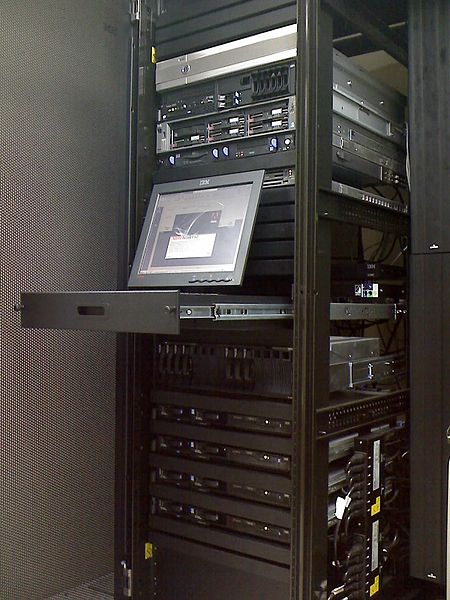If you don’t know exactly what a data center is and what it’s used for, don’t worry, you’re not alone. Data centers are very important to the operations of many thousands of businesses, as well as millions of people. A data center is a facility that centralizes an organization’s IT operations and equipment and where it stores, manages, and disseminates all kinds of information. Data centers house networks’ most critical systems and are vital to the continuity of daily operations. Consequentially, the security and reliability of data centers and their information is a top priority for organizations.
Data center facilities generally include redundant (backup) power supplies, redundant data communications connections, environmental controls (e.g., air conditioning, heat and fire protection, etc.), and various security devices. On a larger scale, data centers can use as much electricity as a small town!
Although most data center designs are unique, they can generally be classified as “Internet” or “enterprise” (or “internal”) data centers. Internet-facing data centers usually support relatively few applications, are typically browser-based, and have many users (typically unknown). In contrast, enterprise data centers service fewer users but they host more applications that vary from generic to highly-custom applications.
Enterprise-class colocation and cloud services data center (AIS “Van Buren,” Phoenix)
Elements of a Data Center
Regardless of classification, an effective data center operation is achieved through a balanced investment in the facility, infrastructure, equipment, and people. Here are the elements of a data center:
- Facility: the location and usable space that is available for IT equipment. Providing 24/7 access to information makes data centers (especially a large one) some of the most energy-consuming facilities in the world. Emphasis is placed on design to optimize white space and environmental control to keep equipment within manufacturer-specified temperature/humidity range.
- Support infrastructure: equipment that helps sustain the highest level of availability possible. The Uptime Institute defines four tiers data centers can fall under, with availability ranging from 99.671% – 99.995%. Some components for supporting infrastructure include:
- Uninterruptible power sources (UPS) – battery banks, generators, and redundant power sources
- Environmental control – computer room air conditioners (CRAC), heating, ventilation, and air conditioning (HVAC) systems, and exhaust systems
- Physical security systems – biometrics and video surveillance systems
- IT equipment: equipment for IT operations and storage of the organization’s data. This includes servers, storage hardware, cables, and racks, as well as information security elements such as firewalls.
- Operations staff: IT professionals that monitor operations and maintain IT and infrastructural equipment around the clock.
Inside of colocation and cloud services data center (AIS “Lightwave,” San Diego)
Data Center Solutions
So, what exactly do data centers offer? What’s so great about them versus doing everything in-house? In short, a lot. Data centers such as those operated by AIS (American Internet Services) include the following offerings:
- Colocation Services
- Cloud Services
- Independent Network Connectivity
- Disaster Recovery
- Managed Storage
- Managed Security
- High Availability
These services and much more are managed professionally by IT administrators who stay up-to-date with the latest technology and ultimately help a data center’s overall efficiency.
Server rack inside of a data center
Concerns and Threats
IT operations are a crucial aspect of business operations around the world. One of the biggest concerns is the continuity of operation. Because companies rely heavily on IT systems to run their operations, if a system becomes unavailable (e.g., unstable network, power outages, etc.), company operations may be impaired or stopped completely.
Information security is also a concern, and for this reason a data center has to offer a secure environment which minimizes the chances of a security breach. Data centers must keep high standards for assuring the integrity and functionality of their hosted computer environments. This is accomplished through redundancy of both fiber optic cables and power, which includes emergency backup power generation.
Organizations are experiencing rapid IT growth but their in-house data centers often are aging. Industry research company International Data Corporation (IDC) puts the average age of a corporate data center at nine years old. A separate research company, Gartner, claims that in-housedata centers older than seven years are obsolete.
While dealing with outdated and now obsolete services and offerings, IT engineers and data center specialists are increasingly looking for ways to modernize data centers, making them more appealing to organizations as well as energy-efficient. Data center “transformations” are designed to take advantage of the performance and energy efficiency increases of newer IT equipment and capabilities, such as cloud computing among others. “Transformation” is an on-going process and one that is proving to be very effective.
Moving Forward
Data centers have evolved significantly in recent years, adopting technologies such as virtualization to optimize resource utilization and increase IT flexibility. As enterprise IT needs continue to evolve toward on-demand services, many organizations are moving toward cloud-based services and infrastructure. Recent focus has also been placed on initiatives to reduce the large energy consumption of data centers by incorporating more efficient technologies and practices in data center management to minimize environmental impact. Data centers built to these standards have been coined “green data centers.”
The good news is that data centers aren’t reserved for any specific “type” of organizations any longer; they’ve become accessible to almost anyone. Even if in-house IT operations are conceivable for small or large companies, wise IT administrators are choosing to outsource some portions of IT management. In the long run, it saves time, money, and manpower – and it’s much less of a headache.
Finding a data center isn’t necessarily hard, but finding the right one might prove to be a bit more challenging. Be sure you outline your organization’s specific goals before choosing a data center.
Sources: paloaltonetworks.com, wikipedia.org















